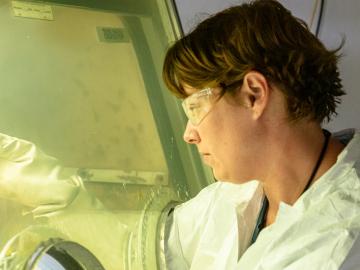Filter News
Area of Research
- Advanced Manufacturing (7)
- Biology and Environment (31)
- Building Technologies (1)
- Clean Energy (41)
- Computational Biology (1)
- Computational Engineering (1)
- Computer Science (3)
- Electricity and Smart Grid (1)
- Fusion and Fission (9)
- Fusion Energy (1)
- Isotopes (9)
- Materials (3)
- Materials for Computing (12)
- Mathematics (1)
- National Security (4)
- Neutron Science (8)
- Nuclear Science and Technology (1)
- Quantum information Science (3)
- Sensors and Controls (1)
- Supercomputing (14)
- Transportation Systems (1)
News Type
Date
News Topics
- 3-D Printing/Advanced Manufacturing (16)
- Advanced Reactors (2)
- Artificial Intelligence (5)
- Big Data (3)
- Bioenergy (12)
- Biology (18)
- Biomedical (6)
- Biotechnology (4)
- Buildings (6)
- Chemical Sciences (3)
- Clean Water (8)
- Climate Change (10)
- Composites (3)
- Computer Science (21)
- Coronavirus (5)
- Critical Materials (2)
- Cybersecurity (2)
- Decarbonization (4)
- Energy Storage (10)
- Environment (34)
- Exascale Computing (2)
- Frontier (1)
- Fusion (3)
- Grid (6)
- High-Performance Computing (14)
- Isotopes (8)
- ITER (3)
- Materials (21)
- Materials Science (13)
- Mathematics (1)
- Mercury (3)
- Microscopy (6)
- Nanotechnology (5)
- National Security (4)
- Net Zero (1)
- Neutron Science (10)
- Nuclear Energy (4)
- Physics (2)
- Polymers (2)
- Quantum Computing (2)
- Quantum Science (7)
- Security (2)
- Space Exploration (4)
- Statistics (1)
- Summit (4)
- Sustainable Energy (27)
- Transportation (14)
Media Contacts

Despite challenges posed by the COVID-19 pandemic, research at ORNL in 2021 continued apace, with developments across the lab’s broad science and technology missions. Among our most popular news stories in the past year:

The world is full of “huge, gnarly problems,” as ORNL research scientist and musician Melissa Allen-Dumas puts it — no matter what line of work you’re in. That was certainly the case when she would wrestle with a tough piece of music.

Burak Ozpineci started out at ORNL working on a novel project: introducing silicon carbide into power electronics for more efficient electric vehicles. Twenty years later, the car he drives contains those same components.

It’s elemental — scientists agree that the periodic table is incomplete. And when it comes to unveiling parts of the periodic table yet undiscovered, ORNL is doing some heavy lifting.

Biologist Larry York’s fascination with plant roots has spurred his research across four continents and inspired him to create accessible tools that enable others to explore the underground world.

An analysis by Oak Ridge National Laboratory shows that using less-profitable farmland to grow bioenergy crops such as switchgrass could fuel not only clean energy, but also gains in biodiversity.

A discovery by Oak Ridge National Laboratory researchers may aid the design of materials that better manage heat.

Oak Ridge National Laboratory researchers determined that designing polymers specifically with upcycling in mind could reduce future plastic waste considerably and facilitate a circular economy where the material is used repeatedly.

A study by Department of Energy researchers detailed a potential method to detect the novel coronavirus

Energy Secretary Jennifer Granholm visited ORNL on Nov. 22 for a two-hour tour, meeting top scientists and engineers as they highlighted projects and world-leading capabilities that address some of the country’s most complex research and technical challenges.




